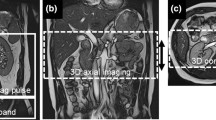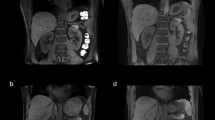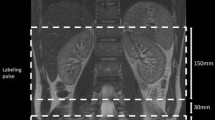Abstract
Objectives
The purpose of this study was to investigate the feasibility of non-contrast renal MRA using multi-shot gradient echo planar imaging (MSG-EPI) with a 3-T MRI system.
Methods
Seventeen healthy volunteers underwent non-contrast renal MRA using MSG-EPI and balanced steady-state free precession (b-SSFP) sequences on a 3-T MRI system. Two radiologists independently recorded the images’ contrast, noise, sharpness, artifacts, and overall quality on 4-point scales. The signal-to-noise ratio (SNR) for the renal artery, the contrast ratio (CR) between the renal artery and erector spinae, and acquisition time were compared between the two sequences.
Results
The SNR and CR were significantly higher with MSG-EPI than with the b-SSFP sequence (17.80 ± 3.67 vs. 10.84 ± 2.86 and 0.77 ± 0.05 and 0.66 ± 0.09, respectively; p < 0.05), and the acquisition time was significantly lower (164.5 ± 34.0 vs. 261.5 ± 39.3 s, respectively; p < 0.05). There were significant differences in image contrast, noise, sharpness, artifacts, and overall image quality between the two sequences (p < 0.01).
Conclusions
The MSG-EPI sequence is a promising technique that can shorten the scan time and improve the image quality of non-contrast renal MRA with a 3-T MRI system.
Key Points
• The multi-shot gradient echo planar imaging with an inversion pulse is a brand-new fast scan technique for an unenhanced renal MRA.
• The image quality of multi-shot gradient echo planar imaging is better than that of b-SSFP for an unenhanced renal MRA.





Similar content being viewed by others
Abbreviations
- 3D:
-
Three-dimensional
- b-SSFP:
-
Balanced steady-state free precession
- CR:
-
Contrast ratio
- EPI:
-
Echo planar imaging
- MRA:
-
Magnetic resonance angiography
- MSG:
-
Multi-shot gradient echo
- PPU:
-
Peripheral pulse unit
- ProSet:
-
Principle of selective excitation technique
- ROI:
-
Regions of interest
- SD:
-
Standard deviation
- SI:
-
Signal intensity
- SNR:
-
Signal-to-noise ratio
- SPIR:
-
Spectral presaturation with inversion recovery
References
Prince MR, Narasimham DL, Stanley JC et al (1995) Breath-hold gadolinium-enhanced MR angiography of the abdominal aorta and its major branches. Radiology 197:785–792. https://doi.org/10.1148/radiology.197.3.7480757
Fain SB, King BF, Breen JF, Kruger DG, Riederer SJ (2001) High-spatial-resolution contrast-enhanced MR angiography of the renal arteries: a prospective comparison with digital subtraction angiography. Radiology 218:481–490. https://doi.org/10.1148/radiology.218.2.r01fe36481
Penfield JG, Reilly RF Jr (2007) What nephrologists need to know about gadolinium. Nat Clin Pract Nephrol 3:654–668. https://doi.org/10.1038/ncpneph0660
Perazella MA (2009) Current status of gadolinium toxicity in patients with kidney disease. Clin J Am Soc Nephrol 4:461–469. https://doi.org/10.2215/CJN.06011108
Kuo PH, Kanal E, Abu-Alfa AK, Cowper SE (2007) Gadolinium-based MR contrast agents and nephrogenic systemic fibrosis. Radiology 242:647–649. https://doi.org/10.1148/radiol.2423061640
Maki JH, Wilson GJ, Eubank WB, Glickerman DJ, Millan JA, Hoogeveen RM (2007) Navigator-gated MR angiography of the renal arteries: a potential screening tool for renal artery stenosis. AJR Am J Roentgenol 188:W540–W546. https://doi.org/10.2214/AJR.06.1138
Herborn CU, Watkins DM, Runge VM, Gendron JM, Montgomery ML, Naul LG (2006) Renal arteries: comparison of steady-state free precession MR angiography and contrast-enhanced MR angiography. Radiology 239:263–268. https://doi.org/10.1148/radiol.2383050058
Maki JH, Wilson GJ, Eubank WB, Glickerman DJ, Pipavath S, Hoogeveen RM (2007) Steady-state free precession MRA of the renal arteries: breath-hold and navigator-gated techniques vs. CE-MRA. J Magn Reson Imaging 26:966–973. https://doi.org/10.1002/jmri.21134
Stafford RB, Sabati M, Haakstad MJ, Mahallati H, Frayne R (2008) Unenhanced MR angiography of the renal arteries with balanced steady-state free precession Dixon method. AJR Am J Roentgenol 191:243–246. https://doi.org/10.2214/AJR.07.3076
Shonai T, Takahashi T, Ikeguchi H, Miyazaki M, Amano K, Yui M (2009) Improved arterial visibility using short-tau inversion-recovery (STIR) fat suppression in non-contrast-enhanced time-spatial labeling inversion pulse (Time-SLIP) renal MR angiography (MRA). J Magn Reson Imaging 29:1471–1477. https://doi.org/10.1002/jmri.21792
Glockner JF, Takahashi N, Kawashima A et al (2010) Non-contrast renal artery MRA using an inflow inversion recovery steady state free precession technique (Inhance): comparison with 3D contrast-enhanced MRA. J Magn Reson Imaging 31:1411–1418. https://doi.org/10.1002/jmri.22194
Khoo MM, Deeab D, Gedroyc WM, Duncan N, Taube D, Dick EA (2011) Renal artery stenosis: comparative assessment by unenhanced renal artery MRA versus contrast-enhanced MRA. Eur Radiol 21:1470–1476. https://doi.org/10.1007/s00330-011-2086-6
Worters PW, Saranathan M, Xu A, Vasanawala SS (2012) Inversion-recovery-prepared Dixon bSSFP: initial clinical experience with a novel pulse sequence for renal MRA within a breathhold. J Magn Reson Imaging 35:875–881. https://doi.org/10.1002/jmri.23503
Bernstein MA, Huston J 3rd, Ward HA (2006) Imaging artifacts at 3.0T. J Magn Reson Imaging 24:735–746. https://doi.org/10.1002/jmri.20698
Stehling MK, Turner R, Mansfield P (1991) Echo-planar imaging: magnetic resonance imaging in a fraction of a second. Science 254:43–50
Herzka DA, Kellman P, Aletras AH, Guttman MA, McVeigh ER (2002) Multishot EPI-SSFP in the heart. Magn Reson Med 47:655–664
Deshpande VS, Wielopolski PA, Shea SM, Carr J, Zheng J, Li D (2001) Coronary artery imaging using contrast-enhanced 3D segmented EPI. J Magn Reson Imaging 13:676–681
Bhat H, Yang Q, Zuehlsdorff S, Li K, Li D (2010) Contrast-enhanced whole-heart coronary magnetic resonance angiography at 3 T using interleaved echo planar imaging. Invest Radiol 45:458–464. https://doi.org/10.1097/RLI.0b013e3181d8df32
Iyama Y, Nakaura T, Nagayama Y et al (2018) Single-breath-hold whole-heart unenhanced coronary MRA using multi-shot gradient echo EPI at 3T: comparison with free-breathing turbo-field-echo coronary MRA on healthy volunteers. Magn Reson Med Sci 17:161–167. https://doi.org/10.2463/mrms.mp.2017-0037
Urata J, Miyazaki M, Wada H, Nakaura T, Yamashita Y, Takahashi M (2001) Clinical evaluation of aortic diseases using nonenhanced MRA with ECG-triggered 3D half-Fourier FSE. J Magn Reson Imaging 14:113–119. https://doi.org/10.1002/jmri.1160
Miyazaki M, Lee VS (2008) Nonenhanced MR angiography. Radiology 248:20–43. https://doi.org/10.1148/radiol.2481071497
Braidy C, Daou I, Diop AD et al (2012) Unenhanced MR angiography of renal arteries: 51 patients. AJR Am J Roentgenol 199:W629–W637. https://doi.org/10.2214/AJR.12.8513
Potthast S, Maki JH (2008) Non-contrast-enhanced MR imaging of the renal arteries. Magn Reson Imaging Clin N Am 16:573–584, vii. https://doi.org/10.1016/j.mric.2008.07.007
Morita S, Masukawa A, Suzuki K, Hirata M, Kojima S, Ueno E (2011) Unenhanced MR angiography: techniques and clinical applications in patients with chronic kidney disease. Radiographics 31:E13–E33. https://doi.org/10.1148/rg.312105075
Skare S, Newbould RD, Clayton DB, Albers GW, Nagle S, Bammer R (2007) Clinical multishot DW-EPI through parallel imaging with considerations of susceptibility, motion, and noise. Magn Reson Med 57:881–890. https://doi.org/10.1002/mrm.21176
Park SY, Kim CK, Kim E, Park BK (2015) Noncontrast-enhanced magnetic resonance renal angiography using a repetitive artery and venous labelling technique at 3 T: comparison with contrast-enhanced magnetic resonance angiography in subjects with normal renal function. Eur Radiol 25:533–540. https://doi.org/10.1007/s00330-014-3416-2
Funding
The authors state that this work has not received any funding.
Author information
Authors and Affiliations
Corresponding author
Ethics declarations
Guarantor
The scientific guarantor of this publication is Toshinori Hirai.
Conflict of interest
Masami Yoneyama is an employee of Philips Japan. The other authors declare no conflicts of interest in regard to the products under investigation or the subject matter discussed in this manuscript.
Statistics and biometry
No complex statistical methods were necessary for this paper.
Informed consent
Written informed consent was obtained from all subjects (volunteers) in this study.
Ethical approval
Institutional Review Board approval was obtained.
Methodology
• prospective
• experimental
• performed at one institution
Additional information
Publisher’s note
Springer Nature remains neutral with regard to jurisdictional claims in published maps and institutional affiliations.
Rights and permissions
About this article
Cite this article
Morita, K., Nakaura, T., Yoneyama, M. et al. Non-contrast renal MRA using multi-shot gradient echo EPI at 3-T MRI. Eur Radiol 31, 5959–5966 (2021). https://doi.org/10.1007/s00330-020-07653-4
Received:
Revised:
Accepted:
Published:
Issue Date:
DOI: https://doi.org/10.1007/s00330-020-07653-4




